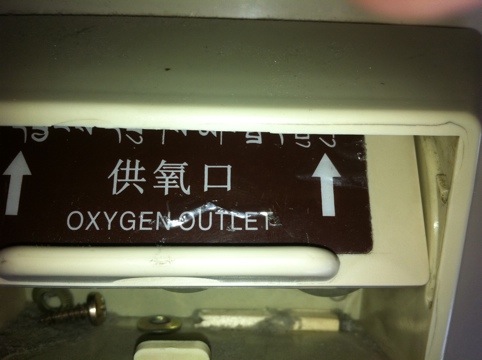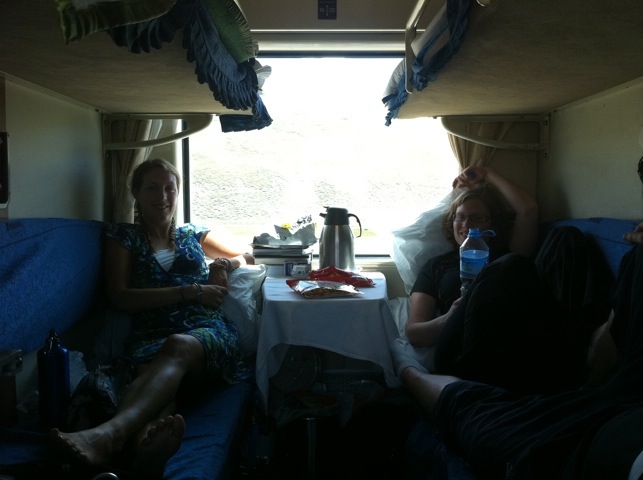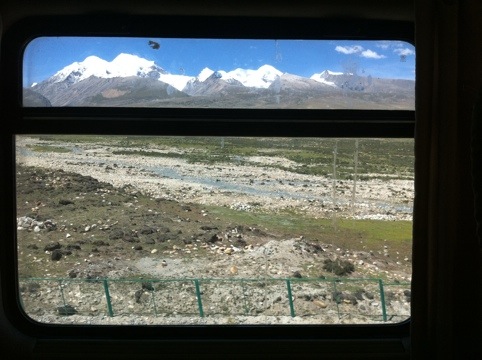It’s 7am, we’re on day two of the train journey across China and I’ve just seen the first snow-capped mountains in the distance.
We were helpfully woken a few minutes ago by all the lights being switched on, just as dawn was breaking outside. All of China is in the same time zone (Beijing time, naturally), it should really be quite a bit earlier than 7am (it’s midnight in the UK).

Let me describe the world around me right now. Inside the train, we’re in a six person sleeper car, I’m on the bottom bunk, and Laura’s somewhere way up above on the second story, next to the air conditioning on the roof. There’s oxygen being fed in through a panel next to each bunk (they switched it on last night as we started ascending properly to the 5072m pass we go through this morning). Our cabin is at the end of the carriage, which means the smells and sounds are less serene – every 30 seconds or so there’s the sound of someone hocking and spitting, and the smell is overwhelmingly of cigarette smoke, as people can smoke in the gap between carriages – but since there are no doors, and the windows are all shut due to air conditioning, it just wafts down to us.
In contrast to the cramped and smokey interior, outside is a wide open plain, with mountains in the distance and a vast foreground of grazing land, occasionally punctuated by shepherds in white tents with their flocks, and the occasional lorry on the road running alongside the track. The sky fills much of what you can see, a smooth gradient of blues against the rough and varied landscape beneath.
If there’s one thing this journey makes you realise, it’s that China is awe-inspiringly huge. The 36 hours so far have seen the whole range of landscapes: urban Beijing with its skyscrapers and smog; desert replete with sand dunes studded with wild grasses; wide brown rivers swirling amid rust-red hillsides with corn growing in the fields as far as the eye can see. And now, permafrost – desolate freezing planes iced with a hint of snow, and the odd line of tibetan prayer flags amid roaming herds of animals.
This railway is seen as a crowning accomplishment of modern China (although the Tibetans understandably do not feel the same way). It’s the highest altitude railway in the world, and was only completed in 2006 after some unlikely engineering – two oxygen ‘factories’ to supply the train, 675 bridges spanning 160km, and networks of pipes feeding liquid nitrogen into the ground beneath the track – to keep it frozen and stable during summer. Oh, and it goes through an earthquake prone region, so there are seismic sensors along the track. And the cost? A whopping $3.6 billion USD.
As our guidebook clearly points out, this is all a part of China’s plan to further tether Tibet to the rest of the country, encouraging greater migration and hence diluting the Tibetan culture and further undermining regional autonomy. This might seen like an obvious Bad Thing, but it poses some interesting questions about development. We live in an ever more connected world, as modern transport and communication break down barriers, creating more of a melting pot – and when done badly, taking away the identity and culture of individual peoples through this process. But how should modern developments be embraced responsibly? Who are we in the west to deny the benefits that come with greater transport, trade and communication, even if that does mean the traditional way of life is changed forever?
Our guidebook makes another interesting point – increased interaction has meant that more Chinese understand and appreciate the Tibetan way of life, to the point that they want to preserve it in its own right. The thinking goes: if you don’t feel threatened by something, you don’t need to try and destroy it.
What happens to Tibet and it’s unique identity remains to be seen – but it’s pretty clear that the region is on a journey just as interesting as the one Laura and I are on.
Simon



Sounds like an epic and eye-opening journey in an amazing landscape. Hope you enjoy Tibet.